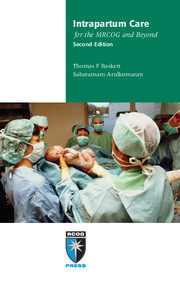Book contents
- Frontmatter
- Contents
- Preface
- Abbreviations
- 1 Improving intrapartum care
- 2 First stage of labour
- 3 Second stage of labour
- 4 Fetal surveillance in labour
- 5 Third stage of labour
- 6 Lower genital tract trauma
- 7 Induction of labour
- 8 Preterm labour and prelabour rupture of membranes
- 9 Assisted vaginal delivery
- 10 Shoulder dystocia
- 11 Breech vaginal delivery
- 12 Twin and triplet delivery
- 13 Caesarean section
- 14 Vaginal birth after caesarean section
- 15 Uterine rupture
- 16 Emergency obstetric hysterectomy
- 17 Cord prolapse
- 18 Antepartum haemorrhage
- 19 Postpartum haemorrhage
- 20 Acute uterine inversion
- 21 Amniotic fluid embolism
- 22 Disseminated intravascular coagulation
- 23 Acute tocolysis
- 24 Severe pre-eclampsia and eclampsia
- 25 Neonatal resuscitation
- 26 Perinatal loss: management of late fetal death and stillbirth
- Index
1 - Improving intrapartum care
Published online by Cambridge University Press: 05 July 2014
- Frontmatter
- Contents
- Preface
- Abbreviations
- 1 Improving intrapartum care
- 2 First stage of labour
- 3 Second stage of labour
- 4 Fetal surveillance in labour
- 5 Third stage of labour
- 6 Lower genital tract trauma
- 7 Induction of labour
- 8 Preterm labour and prelabour rupture of membranes
- 9 Assisted vaginal delivery
- 10 Shoulder dystocia
- 11 Breech vaginal delivery
- 12 Twin and triplet delivery
- 13 Caesarean section
- 14 Vaginal birth after caesarean section
- 15 Uterine rupture
- 16 Emergency obstetric hysterectomy
- 17 Cord prolapse
- 18 Antepartum haemorrhage
- 19 Postpartum haemorrhage
- 20 Acute uterine inversion
- 21 Amniotic fluid embolism
- 22 Disseminated intravascular coagulation
- 23 Acute tocolysis
- 24 Severe pre-eclampsia and eclampsia
- 25 Neonatal resuscitation
- 26 Perinatal loss: management of late fetal death and stillbirth
- Index
Summary
Every mother and her family look forward to normal pregnancy, labour and delivery with a healthy outcome for mother and newborn. The prime responsibility of the caregivers is to ensure this safe outcome and emotional satisfaction in the physiological process of birth.
Broadly speaking, there are four categories of pregnancy:
• the majority of women have a normal pregnancy with spontaneous onset of labour culminating in a normal vaginal delivery
• some women have pre-existing medical conditions that may influence the outcome of pregnancy, such as diabetes, chronic hypertension and obesity
• some women develop obstetric disorders during pregnancy that may have an impact on the pregnancy, labour and delivery, such as preeclampsia and obstetric haemorrhage
• in a small number of women, social and psychological factors can have an impact on the progress of pregnancy, labour and delivery.
It is the duty of midwives and obstetricians to provide appropriate care to accommodate the above circumstances.
Surveys in the UK suggest that 90% or more of mothers are satisfied, or more than satisfied, with the care given in pregnancy and labour. The UK has a maternal mortality rate of about 11/100 000 births, while the perinatal mortality rate is about 10/1000; these rates are not low compared with some developed countries and are relatively static. However, the Eighth Report on Confidential Enquiries into Maternal Deaths in the United Kingdom suggests that 50–70% of maternal deaths are associated with substandard care.
- Type
- Chapter
- Information
- Intrapartum Care for the MRCOG and Beyond , pp. 1 - 8Publisher: Cambridge University PressPrint publication year: 2011



